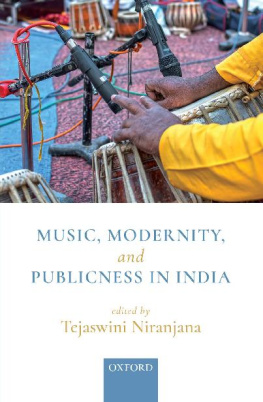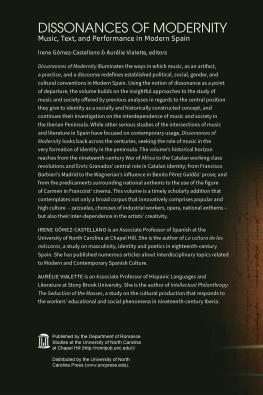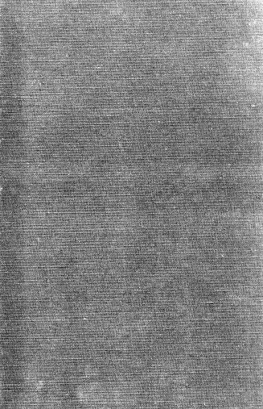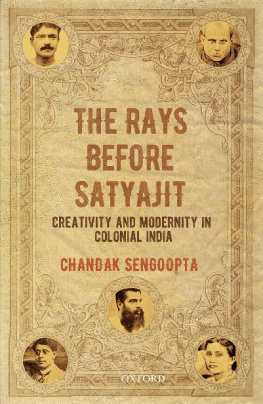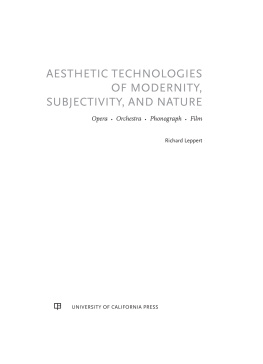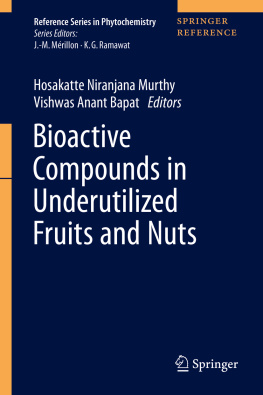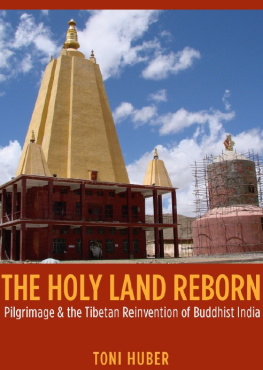Music, Modernity, and Publicness in India
Music, Modernity, and Publicness in India
Edited by
Tejaswini Niranjana
Oxford University Press is a department of the University of Oxford.
It furthers the Universitys objective of excellence in research, scholarship,
and education by publishing worldwide. Oxford is a registered trademark of
Oxford University Press in the UK and in certain other countries.
Published in India by
Oxford University Press
22 Workspace, 2nd Floor, 1/22 Asaf Ali Road, New Delhi 110 002
Oxford University Press, 2020
The moral rights of the authors have been asserted.
First Edition published in 2020
All rights reserved. No part of this publication may be reproduced, stored in
a retrieval system, or transmitted, in any form or by any means, without the
prior permission in writing of Oxford University Press, or as expressly permitted
by law, by licence, or under terms agreed with the appropriate reprographics
rights organization. Enquiries concerning reproduction outside the scope of the
above should be sent to the Rights Department, Oxford University Press, at the
address above.
You must not circulate this work in any other form
and you must impose this same condition on any acquirer.
ISBN-13 (print edition): 978-0-19-012112-9
ISBN-10 (print edition): 0-19-012112-2
ISBN-13 (eBook): 978-0-19099020-6
ISBN-10 (eBook): 0-19-099020-1
Typeset in ITC Giovanni Std 9.5/13
by The Graphics Solution, New Delhi 110 092
Printed in India by Rakmo Press, New Delhi 110 020
Contents
Tejaswini Niranjana
Lakshmi Subramanian
Adrian McNeil
Tejaswini Niranjana
Urmila Bhirdikar
Amlan Das Gupta
Vebhuti Duggal
Abhija Ghosh
Vibodh Parthasarathi
Kaley Mason
Aditi Deo
In the fall of 2013, I was contacted by Tejaswini Niranjana, who enquired whether I would like to participate in a small workshop she was organizing in Berlin, Germany, on the theme of music, modernity, and the public sphere. Both of us had been fellows at the Wissenschaftskolleg in Berlin at different points in the past, and she had learnt that we shared similar interests on this question, if from quite differing perspectives. While she was exploring the topic from her position as a scholar of contemporary North Indian music with nods towards gender and postcolonial theory, I had been thinking about it in a nineteenth-century European context of emerging bourgeois sensibilities that were cultivated on the parlour piano. Still, I was delighted to accept her invitation. It gave us a chance to return to Berlin, where we not only shared many happy memories about our time on the Wiko campus in Gruenewald, but also had a wonderful opportunity to explore the question of musical modernity and the public sphere from a more cosmopolitan, global perspective.
Thanks to generous funding from the Wissenschaftskolleg (and especially the enthusiastic support of its academic director, Reinhard Meyer-Kalkus), the conference took place on the Wiko campus from 24 to 25 April 2014. Some two dozen scholars from around the world attended it. Together, there was presented a panoramic world overview of the ways in which musical activity in the public sphere helped to instigateand at times, reorientchanges that we have come to associate with the modern subject. One premise of the conference was that Habermass theory of the bourgeois public sphere might be a fruitful beginning for exploring the subject of music and modernity. But over the course of our meeting in Berlin, it soon became clear that the theory was inadequate in dealing with the more variegated musical publics that emerged in Asia, South America and Africa in the course of the twentieth century. Indeed, one result of our conference was the identification of many differing registers by which a musical public might be constituted and analysed from a global perspective.
After the conference, Teju and I stayed in touch to see where we might go after it. For all the exhilarating stories we heard during the two days spent in Berlin, we felt that the subject of musical modernity and the public sphere was so diffuse that our next step should be to draw a more narrowly defined perimeter within our subject, upon which we might focus in greater detail. As it turned out, a number of the most exciting papers at the Wiko conference concerned East and South Asian musical history. While there is, of course, no shortage of scholarly writings on South Asian music, little of it explores explicitly the topic of modernity linked with the public sphere. Perhaps this could be the focus we were looking for.
As luck would have it, the University of Chicago was about to open a new academic centre in New Delhi the year after our conference. As a member of a faculty committee that was set up to advise on this centre, I suggested to Teju that we use the opportunity to organize a conference there. Thanks once again to some generous funding, this time from my universitys Delhi Centre and its director, Professor Gary Tubbs, we were able to bring together two dozen scholars from across Asia to gather between 26 and 28 February 2016 for our second conference on Music, Modernity, and the Public Sphere.
There was little overlap between the attendees of the two conferences. (Aside from Teju and myself, there was the film-maker Surabhi Sharma.) Over the three days of our Delhi conference, we heard a large number of wonderful papers on this theme, with a focus on the Asian experience. A highlight was the participation of Dipesh Chakrabarty (the Lawrence A. Kimpton Distinguished Service Professor of History and South Asian Languages and Civilizations at the University of Chicago), who delivered a brilliant and entertaining response to these papers. Teju and I were impressed by the cohesion and quality of all the presentations at the conference (something academics well know cannot always be assumed at such venues). We decided that the next step was to gather as many of these papers as we could and have them revised for publication. The result is now the present volume in your hands or on your computer screen.
If the focus of these essays is on the Indian musical experience in the long twentieth century, we hope that readers with knowledge of other musical traditions will find much that is familiar here, while also much to learn from. In this volume, authors explore questions in a postcolonial, Indian context that could be asked about almost any nation state around the globe: How is it that music seems to play such a catalytic role in forming identities of nationhood, class, or ethnicity? And how do twentieth-century technologies of sound reproduction and commercial marketing contribute to that role? A number of authors explore how tensions between classical and vernacular musical canons help in the formation of national or ethnic identities.
In what way do differing genres of popular music (love songs, folk tunes, film scores) help to form the modern subject? Above all, each author asked how music that might be originally cultivated in more intimate, private spheres could become transplanted into a public ecology and thereby become a force by which elements of social modernism may be stimulatedor perhaps retarded. These questions and many more are subtly explored in this rich volume of essays from a broad Indian context. To be sure, the answers proffered by many of our authors are nuanced and hedged; certainly there is no presumption that there are universal answers to be found in the focused and historically contingent cases studies to be found here, no singular theory that will account for the rich diversity of stories that we will hear. At the same time, though, we will see how there are common forces of modernity that are shared globally, and music is an ideal subject by which to explore and contrast how people in each culture respond to these forces musically; how, in other words, they ultimately learn to find their own voices.



